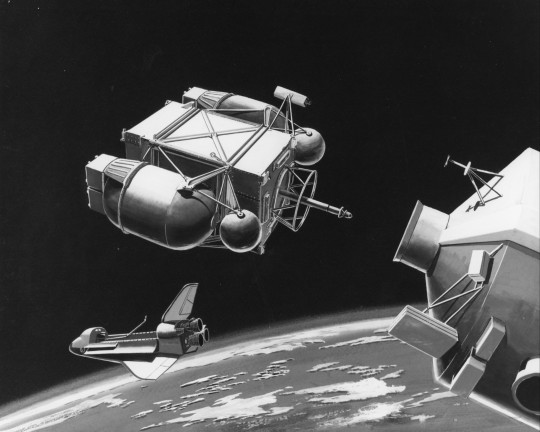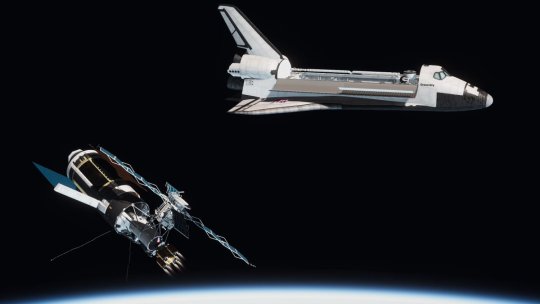#teleoperation
Explore tagged Tumblr posts
Text
👨🤖 Phoenix Bot: O Humanoide que Revoluciona a Robótica!
👨🤖 Phoenix Bot: O Humanoide que Revoluciona a Robótica! áudio da matéria aqui: Já viu muitos robôs humanoides por aí? 🚫 Esqueça tudo! O Phoenix Bot da Sanctuary AI chegou para mudar o jogo. Com “as melhores mãos robóticas do mundo” ✌️ e um movimento autônomo incrível, ele está deixando para trás até os robôs da Tesla e Figure! 🚀 👉 O que torna o Phoenix tão especial? Velocidade absurda: Ele se…
0 notes
Link
Astronomy Daily - The Podcast: S03E185 Welcome to Astronomy AstroDailyPod, your trusted source for the latest in Space and astronomy news. Join hosts Steve and Hallie for an enlightening journey through the cosmos, packed with the latest updates and stories that are sure to ignite your curiosity. Highlights: - Hunter's Moon Delight: Experience the beauty of the Hunter's Moon as observed from Newcastle, Australia. This celestial event has captivated skywatchers worldwide, overtaking the excitement of recent auroras. - SpaceX Satellite Launch: SpaceX successfully launched 20 spare OneWeb satellites to bolster the French operator UTelsat's Low Earth Orbit broadband network. Despite ground infrastructure delays, UTelsat is on track to offer global services by spring. - Moon Train and Robot Rovers: Discover the latest advancements in lunar exploration with remote-controlled robots and NASA's innovative FLOAT project. These developments promise to revolutionise how we explore and utilise the moon's resources. - Orionids Meteor Shower: Prepare for the spectacular Orionids meteor shower, with meteors originating from Halley's comet providing a stunning celestial display. Get tips for the best viewing experience from NASA's experts. - Space Force Mission: True Anomaly and Firefly Aerospace partner for a rapid response mission with the US Space Force, testing the ability to counter orbital threats on short notice. For more Space news, visit our website at astronomydaily.io. There, you can sign up for our free AstroDailyPod newsletter, catch up on all the latest Space and Astronomy news with our constantly updating newsfeed, and listen to all our previous episodes. Don't forget to follow us on social media. Just search for #AstroDailyPod on Facebook, X, YouTube, and TikTok. Thank you for tuning in. This is Steve signing off. Until next time, keep looking up and stay curious about the wonders of our universe. Sponsor Links: NordVPN - www.bitesz.com/nordvpn - currently Up to 74% off + 3 extra months Old Glory - www.bitesz.com/oldglory Sport and Entertainment Merch. Over 100,00 items in stock Proton Mail - www.bitesz.com/protonmail Secure email that protects your privacy Malwarebytes - www.bitesz.com/malwarebytes Premium protection for you and all your devices! Become a supporter of this podcast: https://www.spreaker.com/podcast/astronomy-daily-the-podcast--5648921/support.
#agency#artemis#astronomy#european#hunter's-moon#levitation#lunar#meteor#mission#moon-train#nasa#oneweb#orionids#railway#robot-rovers#satellites#space#spacex#teleoperation#utelsat
0 notes
Link
#AI#artificialintelligence#AutonomousVehicle#AV#driverlesstechnology#Frost&Sullivan#Futurride#Israel#McKinsey&Company#Ottopia#remotedriving#remotedrivingplatform#remote-driverservice#sustainablemobility#TelAviv#teleoperation
0 notes
Photo

Telekom, MIRA test teleoperated shuttles in Bonn Deutsche Telekom AG and MIRA GmbH have jointly launched a pilot project for teleoperated driving. The project partners are testing the shuttle service with teleoperated operation between various Telekom locations The post Telekom, MIRA test teleoperated shuttles in Bonn appeared first on VanillaPlus - The global voice of Telecoms IT. https://www.vanillaplus.com/2023/08/07/82464-telekom-mira-test-teleoperated-shuttles-in-bonn/
#Companies#CSPs News#Network optimisation#News#People#Test & measurement#Deutsche Telekom AG#Katja Dörner#Klaus Kappen#MIRA GmbH#Olga Nevska#Teleoperation#Janmesh Chintankar#VanillaPlus – The global voice of Telecoms IT
0 notes
Text

Earlier version of the Martin Marietta Teleoperator Retrieval System, which would have been used to boost the Skylab Orbital Workshop into a higher orbit by STS-2 Columbia.
"The Teleoperator Retrieval System (TRS), to be used in conjunction with the space shuttle in the early 1980s, approaches a satellite for docking and retrieval. This system will be used to survey, stabilize, and maneuver payloads in low earth orbit."
Date: 1977
NASA ID: S77-002623
#STS-2#Space Shuttle#Space Shuttle Columbia#Columbia#OV-102#Orbiter#NASA#Space Shuttle Program#Teleoperator Retrieval System#TRS#Martin Marietta#Reboost Mission#Skylab Orbital Workshop#Skylab OWS#Skylab#Skylab I#Skylab 1#SL-1#Space Station#Apollo Telescope Mount#ATM#Apollo Program#Apollo Applications Program#Cancelled#1977#concept art#undated#my post
35 notes
·
View notes
Text
I was a teleoperator for a day. If you want to shock the caller, just say "I can't hire anything, I'm stuck."
#Day#my life#Teleoperator#Call#jokes#this a joke#Yesterday they called me#And I didn't do it#Regrets#I called and they answered me
3 notes
·
View notes
Text
Name a better way to start your Wednesday than being yelled at by an old man :')
#they're act so entitled#only good thing about being afab is thst i can put on a sugary sweet voice that usually calms them down a bit#they don't wanna yell and cuss at a lady#some do and those are really rough#the joys of working for a teleoperator#vi says stuff
7 notes
·
View notes
Text
Teleoperation and Telerobotics Market: Current Analysis and Forecast (2024-2032)
According to a new report by UnivDatos Market Insights, the Teleoperation and Telerobotics Market is expected to reach USD by 2032 by growing at a CAGR of ~18.6%.
Introduction
The market of teleoperation and telerobotic systems is developing very fast across the globe, offering a brilliant solution to control machines and robots from a distance. These technologies enable operations to be conducted where they are dangerous or impractical for an operator to be physically present or over huge distances leading to increased output, safety, and effectiveness. Starting from health care, manufacturing, aerospace, and defense, teleoperation and telerobotics are the technologies that break the barriers of industries and explore new remote working and automated possibilities. This article focuses on the fundamental aspects of the teleoperation and telerobotic market today, the factors influencing the market, new trends, challenges, and future advancement of the market.

Market Overview
Teleoperation may in this context be understood as the real-time partial or complete manipulation of machines or systems by a human at a different location to the site of operation. Telerobotics takes this concept a step further by overlaying self-driving features and robotic apparatus to accomplish higher simplicity and precision. These technologies have received large acceptance in fields where direct people participation is unadvisable, unfeasible, or uneconomical. For instance, in the healthcare department, through using of teleoperation systems surgeons practice robotic surgeries, which gives more accurate outcomes and shortens times for patients’ recovery periods. Industrial telerobotics improves production lines and sustains vital structures in hazardous territory, including nuclear power stations and offshore oil-drilling platforms.
The teleoperation and telerobotic market for the global world has shown rapid development because of many factors such as enhancements in robotics technology, artificial intelligence, and utilization of real-time transportation networks. Organizations are now applying these technologies in a bid to cut expenses, minimize hazards, and get better organizational functions. Another major contributor has been 5G technology which has provided faster and less delayed communication that has now become the basis for smooth teleoperation enhancing chances of broader implementations.
Driving forces of the food packaging market
Several key factors are driving the expansion of the global teleoperation and telerobotic market:
Progress in attitude control devices and robotics systems – Modern technology and telerobotic technologies are profoundly benefiting from AI and machine learning which helps the systems learn from the operators.
High-Risk Operations – As various industries push for remote operations due to the hazardous working conditions, mining, oil & gas, and defense are leading adopters of teleoperation systems.
Growing Implementation of New Generation Network – Realization of 5G technology enables the desired high-speed low latency communication required for actual time remote control of robots and machinery.
Increase in the usage of teleoperation in Self-Driven and Semi-Autonomous Cars – The indicated technology in self-driven and semi-self-driven cars is increasing, enabling controllers to oversee cars during complicated maneuvers.
Telemedicine – The need for remote surgeries is increasing due to pandemic or geographic issues and it is pushing the uptake of teleoperated robotic surgery systems.
Emerging Trends in the Market
The teleoperation and telerobotic market is experiencing several exciting trends and technological advancements, which are shaping the future of these systems:
Application of Virtual and Augmented Reality (VR/AR) – VR/AR characterizes the experience through natural and intuitive operations, making interaction through the operating environment easy.
On Human-Robot Collaboration – Industries are now shifting their attention to cobots that interact with human employees, flexibility, and accuracy of work.
Widening of Space Research Uses – Space-bound telerobotic systems are developing into a necessity for space expeditions because astronauts can manipulate planetary surface robotic constructs in scientific analysis and construction.
Advanced Tactile Interfaces – Tactile interfaces are used to provide the operator with a feeling of the physical environment and increase the accuracy and stability of robotic systems used in operations or repair work.
New defense opportunities – Using telerobotic systems for observation, defusing of bombs, and telecontrol of military vehicles without involving human personnel directly in dangerous areas.
Major Uses across Various Industries
The teleoperation and telerobotic market are diverse, with applications across multiple sectors:
Healthcare: Probably the most sophisticated is the utilization of of telerobotic surgery since it allows the actual conducting of surgeries from remote areas and at the same time increased accuracy. Remote diagnostics and remote consultations are also emerging as services, which are indeed widely utilized to expand the scope of healthcare services.
Manufacturing and Industry: In manufacturing, they are applied to real-time control of machines from a distance so that an operator can monitor production without physically intervening. It proves useful in conditions that are dangerous for people such as chemical factories, nuclear power plants, and the like.
Defense and Military Applications: Telerobotic systems have become popular in defense to deal with bombs, spying, and operating unmanned vehicles. These systems assist in preventing the loss of military personnel while at the same time enabling effectiveness.
Space Exploration: Still, telerobotics has been widely implemented and used for space exploration, especially by NASA and other space centers. While rover machines are operated from Earth and remotely study surface conditions of distant planets, perform experiments, and construct space facilities.
Mining and Oil & Gas: In mining, teleoperated vehicles and equipment enable the operator to work in an area that is deep underground, or where conditions are unfriendly to human beings. In the same way, the oil and gas industries employ telerobotics in controlling the operational activities in offshore machinery or in situations where direct human influence is perilous.
Challenges in the Market
Despite the promising growth, the teleoperation and telerobotic market faces several challenges:
High Implementation Costs: The upfront costs of developing and deploying teleoperation and telerobotic systems can be prohibitive, particularly for small and medium-sized enterprises (SMEs). The hardware, software, and network infrastructure required to support these systems can be expensive.
Connectivity Limitations: Despite the emergence of 5G networks, there are still many areas, where stable connection with high speed is required for real-time teleoperation. This issue poses a challenge to the implementation of telerobotic systems in rural or relatively remote regions.
Security Concerns: Like any networked system teleoperation and telerobotic technologies present certain risks among which are risks related to cyber threats. Protecting these systems is of paramount importance, especially for organizations operating in such sectors as defense, healthcare, and essential infrastructure.
Access sample report (including graphs, charts, and figures): https://univdatos.com/get-a-free-sample-form-php/?product_id=42903
Regulatory Hurdles: Telerobotics is highly regulated in sectors including those related to healthcare and defense. Undulating with these regulations may hinder the implementation of new technologies and could pose challenges regarding entrants.
Operator Training and Skill Gaps: The presence of expert opinion to control the systems is extremely valuable in the overall functionality of teleoperated and telerobotic systems. One of the problems faced by most industries is the ability to ensure the workforce is trained sufficiently.
Related Telecom & IT Market Research Industy Report:-
AI Data Center Market: Current Analysis and Forecast (2024-2032)
Millimeter Wave Technology Market: Current Analysis and Forecast (2024-2032)
Conclusion
The teleoperation and telerobotic market at the global level is expected to change industrial processes and their performance significantly, providing them with improved work conditions and opportunities. These technologies are finding application in healthcare, defense, and other sectors to address field operations that otherwise had restricted or dangerous access mechanisms changing the existing paradigms. Growing with the advancements in artificial intelligence, Robotics, and communication networks, this marketing has immense growth potential. Nevertheless, high costs, connectivity, and security issues will be the key factors that will determine how teleoperation and telerobotics can be fully developed to their potential. Over the years, those technologies will continue to grow exponentially, and they will bring dramatic changes to industries and departments as well as promote new forms of remote controlling for more extensive ranges of work.
Contact Us:
UnivDatos Market Insights
Email - [email protected]
Contact Number - +1 9782263411
Website -www.univdatos.com
0 notes
Text
"Remember that the best way to protect your electronics is to unplug them before storms :)" why thank you random teleoperator text message, I'll just develop the ability to see in future so I can predict every storm before it starts
#neri.txt#i honestly don't even know why they sent that#i've had the same teleoperator for years and i don't think they've ever sent me a text#like even ads
0 notes
Link
0 notes
Text

A modern Mellanoid Slime Worm spacecraft, the Ice Giants Explorer. Intended to launch in 2383, it ended up fast-tracked and launched under a completely different mission. It would have explored the four ice giants of the Zwo-Nmu system: Glarpi, Shpler, Euaua, and Flible, with a possible mission extension to distant, never-before-seen planet Schmidt. It's depicted here using its T.E.N.D.R.I.L. (Teleoperated extendible-node robotic interface limb) to deploy one of its many robotic probes to land on a small captured satellite of Shpler, S/2351 S2.
The spacecraft has two main propulsion systems, a fission-impulse drive and a pulsed warp engine. The fission-impulse drive are modified solid-core nuclear-thermal-rockets utilizing subspace field coils on the exhaust end similar to those utilized on starfleet impulse drives. However, the power generation for those impulse coils is provided by a fission reactor, instead of a fusion reactor. This results in approximately a doubling of the specific impulse of the engine while preserving thrust characteristics.
The pulsed warp engine uses a bank of high-density capacitors charged using the fission reactors, to provide short bursts of warp speed. Modern mellanoid transwarp coils can provide speeds of up to warp 5 on the new scale, but are bottlenecked by the power generation and storage rate. As such the pulsed warp drive technology is currently not usable for interstellar exploration, but it does allow for much faster intra-system manuevers. (The bright photon-wakes visible from many astronomical units away, and their associated radiation hazards, are considered an acceptable risk.)

#Mellanoid slime#mellanoid slime worldbuilding#spacecraft#spaceship#ice giant#uranus#neptune#saturn#ringed planet#planetary rings#captured satellited#planet art#space art#rocket#nuclear rocket#liquid droplet radiators
91 notes
·
View notes
Text
The robots at the Tesla event being tele-operated is so funny to me, mostly because I keep thinking about what it must be like to be one of the people doing that. Like, rich people paying you to serve drinks, but you're doing it through a machine that cost tens of thousands of dollars? This is some scifi dystopia stuff. Actually, I think I must have seen it before somewhere, but Surrogates is the closest that comes to mind, and that was people teleoperating fit, attractive robots to live their ideal lives, which is kind of the opposite.
I'm feeling really compelled to cook up a short story about teleoperated robot maids. Maybe some The Jetsons fanfic where Rosie is being run by someone in South America.
57 notes
·
View notes
Text
obsessed with this video, demonstrating live teleoperation of a humanoid robot using body-tracking VR, where the engineers used boxing a punching bag and speed ball as a demonstration of the ability for the robot to make fast movements and resist impacts while actively controlled by a human, because half the comments were critiquing the operator's boxing form and half were making suggestions for design changes for the robot that could make it better at boxing
38 notes
·
View notes
Text
teleoperated doll for training purposes
9 notes
·
View notes
Text




"Skylab with the Teleoperator Retrieval System docked for its first post-Apollo reboost, ahead of refurbishment by a series of Space Shuttle missions"
Render by brickmack: link
#Skylab Orbital Workshop#Skylab OWS#Skylab#Space Station#Apollo Telescope Mount#ATM#NASA#Apollo Program#Apollo Applications Program#Teleoperator Retrieval System#TRS#SpaceTug#Space Tug#artwork#what if#1970s#my post
20 notes
·
View notes